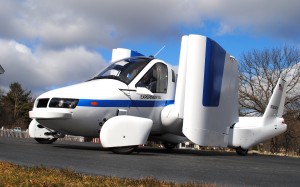It’s not as if Back to the Future, Part II was the film to introduce us to the concept of flying cars.
We had the ConvairCar Model 118 in 1947.
We had The Jetsons in the 1960s.
We had Star Wars in the late-1970s.
We had Blade Runner in the early 1980s.
But the second installment of the Back to the Future trilogy gave us something the others did not that firmly imprinted the idea in our heads: a tangible date.
And we’ve nearly arrived.
October 21, 2015
Unless there are rapid technological and regulatory changes in the next nine months, we’re unlikely to have Goldie Wilson III hover-converting our old road cars into sky-way flyers.
But it turns out, there have been great advances in flying car technology, most notably with Woburn, MA-based Terrafugia—a company dedicated to leading the creation of flying cars, which in their current form are more like small, street-legal airplanes.
Newsweek had some fun with the calendar switch to 2015, interviewing a series of thought-leading futurists about the various technological and cultural shifts depicted in Back to the Future, Part II.
Where are our flying cars!?!?
“In terms of basic design, flying vehicles need lift; cars shouldn’t have lift,” said The New York Times’ Michael Rogers to Newsweek. “In terms of driver skills, a car is basically two-dimensional navigation; an airplane is three dimensional. Big difference in the driving skill required. And finally, the FAA. Consider how cautious the regulators are being about drones, which weigh a few pounds and don’t carry passengers. Multiply that caution by, oh, about a million, and that’s how the regulators will respond to flying cars.”
The Daily Telegraph’s Adrian Berry said: “Well, they could happen. But I think the flying will be entirely computerized. It will be a self-flying car. Otherwise there would be so many accidents, because people are not very good at driving in two dimensions. As for driving in three dimensions, I think it’s a recipe for disaster.”
Just in case you didn’t know what Berry meant, he continued in the Newsweek story: “I’ve thought about them for years and years, but I think they’re terribly dangerous for the whole population. As soon as you start driving things yourself, there will be an awful lot of dead bodies falling out of the sky.”
…
When we gathered in theaters and chuckled at Marty McFly and Doc Brown’s adventures in 2015—30 years into the future per the story—the film’s depiction of 2015 seemed plausible enough, and in fact, the writers got many things correct (mobile digital cameras, 3D theater technology, flat widescreen televisions, video glasses, video conferencing, gesture-based computing, biometrics, thumbprint transactions, etc.)
But not the flying-car bit.
To the filmmakers’ credit, they were never trying to correctly predict the future.
“Rather than trying to make a scientifically sound prediction that we were probably going to get wrong anyway, we figured, let’s just make it funny,” said Bob Gale, who wrote the screenplay. “We knew we weren’t going to have flying cars by the year 2015, but God we had to have those in our movie.”


Comments